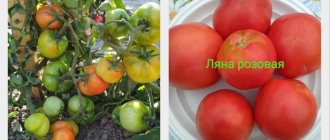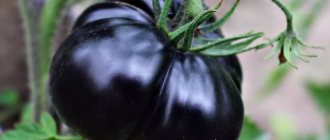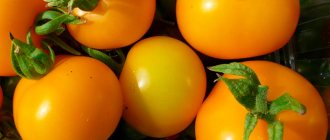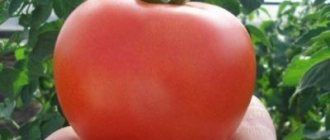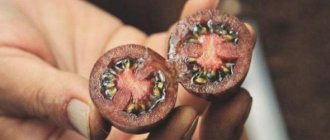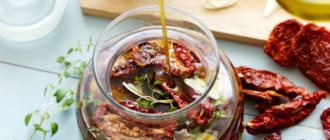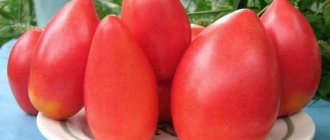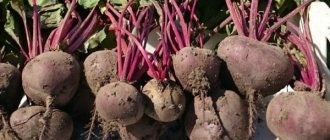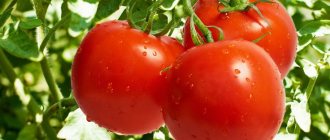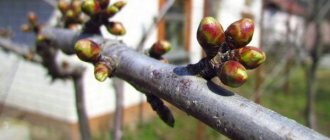Tomato Lyana pink is a subspecies of the popular variety Lyana. It combines all the advantages of the mother variety, but at the same time it also has its own advantages, for example, ultra-early ripening.
| Height | Landing location | Ripening time | Fruit color | Fruit size | Origin | Fruit shape |
| short | Open ground | Ultra early | Pink | Average | Hybrid | Round |
Description of the variety
Description of tomato:
Based on the time of ripening, the tomato is classified as medium-late. The timing of the growing season strongly depends on the region of planting and solar activity: in the middle zone, technical maturity occurs after 95-110 days, in Siberia - no earlier than after 115-120 days.
Plants of determinate type with a stem height of up to 40 cm. A brush of a simple type, laid at least 5-6 leaves.
Fruit
The fruits are small - 6-7 cm in diameter and weighing 60-80 grams. The shape is traditional flat-round. The color of the ripe skin is scarlet with a pink tint.
Other features of tomatoes “Lyana pink”:
- 4-6 seed chambers with a small number of seeds;
- Moderate content of sugar (2%) and solids (5%), high content of ascorbic acid and carotene;
- Dense fleshy pulp.
Description and characteristics of the tomato variety Liana, reviews, photos
An early-ripening, low-growing, determinate, productive tomato variety for open ground and temporary film shelters.
The bush is standard, medium-branched, well-leafed, 35-40 cm high, and does not require pinching. The leaf is of ordinary type, medium size, dark green. The inflorescence is simple, compact. The first inflorescence is laid above 5-6 leaves, subsequent ones every 1-2 leaves.
The fruits are round, smooth, almost all the same size, red in color at maturity, weighing 65-90 grams, good taste for early tomatoes. These tomatoes are universal in purpose - good for early fresh salads, as well as for canning and processing into tomato products. The taste is average.
The variety is resistant to blossom end rot, bacterial spot and macrosporiosis, moderately susceptible to late blight and septoria, and according to the originator, highly susceptible to TMV.
This tomato variety is included in the State Register for the Central and East Siberian regions.
You can now find seeds of the Lyana rosea variety on sale. Differences from ordinary Lyana: the fruits are slightly larger, pearl-pink in color, the height of the bush is 0.6-0.7 meters.
Advantages of the variety: early fruit ripening, excellent quality, high yield, good transportability, keeping quality, resistance to diseases and fruit cracking.
Alina Mikhailovna: “I always plant different varieties and last season I came across Liana tomatoes. I read the reviews of those who planted this variety before, so I took into account the nuances of disease control. As a result, healthy tomatoes grew and I harvested about 30 kg.”
Vasily Fedorovich: “This is not the first time I have grown this variety, so I am well acquainted with its characteristics. To make it easier to care for, I first plant the seeds as seedlings, and then transfer them to the greenhouse.”
We have collected reviews from gardeners and presented them below so that you can study them and draw the right conclusions for yourself. People shared their opinions about the Liana variety, indicating their advantages and disadvantages.
Angela Yurievna, Moscow region
Olga Leonidovna, Saratov region
Tamara Ivanovna, Omsk region
Ksenia Tarasovna, Nizhny Novgorod region
Liliya Fedorovna, Leningrad region
Svetlana Sergeevna, Ivanovo region
Valentina Valentinovna, Moscow region
Nadezhda Vasilievna, Vladimir region
Application of fruits
Tasters from the State Commission for Variety Testing rated the taste of “Lana Rozova” as 5 out of 5 points. The tomato has a balanced sweet and sour taste and exquisite aroma. This makes it ideal for eating fresh or cutting into salads. However, its compact size and good tolerance to heat treatment significantly expand the scope of use of Lyana: the fruits can be used for preparing preserves for the winter, as well as for processing into juice or paste.
REFERENCE : High commercial characteristics and the ability to transport over long distances have made this variety popular among professional farmers growing tomatoes for the needs of the food industry.
Description and characteristics of tomato variety Lyana
If you grew Liang tomatoes, please write if you liked them? Many call this variety the best of all early low-growing tomatoes - do you think the same? How do you rate the disease resistance of this variety? Briefly describe the advantages and disadvantages of this tomato in your opinion. If possible, attach a photo of the entire bush or individual fruits you grew to your comment. Thank you!
Your reviews of the Liang tomato and additions to the description will help many gardeners evaluate this variety objectively and decide whether it is worth planting or not.
The early-ripening tomato variety Liana is valued for its stable fruiting and juicy fruits. This variety has high taste characteristics and universal use.
Pink and raspberry varieties of Liang tomatoes have become widespread among gardeners. The variety has a number of comparative characteristics that distinguish it from other tomatoes.
Appearance
Low-growing and compact bushes reach a height of 50 cm. The plants are characterized by strong foliage and an average branching rate. The growth type is determinate, so stem formation is required. The leaves are miniature, rich green.
Ripe fruits acquire a rounded shape, bright red skin and compact size. The average weight of vegetables is 60-80 g. The pulp is dense and juicy, the number of seeds does not exceed 0.3%.
The Lyana variety was discovered as a result of research at the Transnistrian Research Institute of Agriculture and was officially included in the State Register in the late 1990s.
Given a favorable climate and proper care, it is possible to harvest 2-4 kg of crop from one bush. The fruits begin to ripen 85-95 days after the appearance of the first shoots. If vegetables are grown in Siberia, the ripening time is 110-115 days. Fruiting lasts until the onset of the first autumn cold snap.
Liang's tomatoes are suitable in their characteristics for growing in the East Siberian and Central regions of the country. Tomatoes are considered heat-loving, so in the southern regions it is allowed to plant seeds in open ground. In Central Russia and Siberia, it is recommended to plant plants in a greenhouse. At the same time, the Liana variety is immune to short-term temperature changes.
Tomatoes have a high level of resistance to blossom end rot, dry spot and bacterial spot. To a lesser extent, bushes are susceptible to late blight and septoria. Under unfavorable climatic conditions and improper care, there is a possibility of infection with the tobacco mosaic virus.
The only disadvantage of the Liana variety is its tendency to certain diseases and attacks by harmful insects. The list of positive characteristics includes:
- early maturation;
- universal purpose of the crop;
- good indicator of transportability;
- high nutritional value and taste;
- stable yield.
Bush formation
One of the distinctive features of the Liang tomato variety is its friendly fruiting. The bulk of the fruits ripen in a short period, so harvesting is not delayed. Ripe fruits are carefully picked from the bushes and consumed fresh or used for preservation, processing and in the preparation of various dishes.
The harvested crop can be left for storage. Fruits can be stored in the refrigerator if they are packaged in plastic bags. A dark, cool cellar is also suitable as a location. To prevent tomatoes from rotting, it is necessary to inspect them to identify affected specimens, after which the selected vegetables are laid out in 2-3 layers in wooden boxes.
Growing tomatoes
“Lyana pink” is a universally grown tomato. It can be cultivated in a greenhouse and open ground, in seedlings and without seedlings, from purchased and independently collected seeds.
How to prepare seeds?
Seeds require complete pre-sowing preparation:
- Rejection. Damaged, moldy or unevenly colored seeds are not allowed for planting;
- Disinfection in antiseptic (weak solution of potassium permanganate or hydrogen peroxide);
- 30-minute exposure to growth stimulants (Kornevin, Zircon, Epin);
IMPORTANT : Pre-sowing treatment must be carried out under sterile conditions: containers and equipment must be treated with chlorine solution, manipulations must be carried out with disposable gloves. In addition, the soil used for sowing must be preheated in the oven to 60*C.
- Soaking in melt water for 12-24 hours.
Properly prepared seeds are characterized by increased germination (up to 90%), accelerated growth rates (the growing season is 3-5 days shorter) and higher yield.
Sowing seed material
Sowing is carried out on the 20th of March - early April - approximately 45-55 days before planting in a permanent place. When choosing a sowing date, it is necessary to take into account the climatic zone, solar activity (for normal growing season, seedlings need at least 12 hours of light per day) and the moment of return frosts - it is important that the plants are not exposed to sudden temperature changes immediately after planting.
The usual sowing order is:
- Distribute the seeds in the soil using the square-cluster method at intervals of 2 cm and at a depth of no more than 1 cm;
- Pour plenty of warm water and cover with film;
- After the first shoots appear, remove the shelter and subsequently grow the plants at a temperature of 22-24*C;
- Picking is carried out after unfolding the second sheet.
Young plants need constant moisture and periodic feeding (every 7-14 days). At home, seedlings are fed with complex fertilizers such as “Fertika Lux”. When growing without seedlings, you can use organic matter: 10% mullein solution, 5% bird droppings solution, 20% nettle infusion.
Rules for planting seedlings
Two weeks before planting, seed hardening begins. To do this, the seedlings are placed outside: first for 1-2 hours, then for 2-3, and so gradually increase their stay in the open air to around the clock.
In parallel with hardening off the plants, they are preparing the beds:
- Remove weeds and dig to a depth of 10-15 cm;
- Fertilizers are applied: 2 buckets of humus per 1 sq.m, or complex products - “Biohumus”, “Biomaster” or “Gumi-Omi”.
The plants are transferred with a ball of earth, trying not to affect the root system, and placed in the planting hole so that the bottom leaf is 4-5 cm from the ground.
When planting plants, adhere to the following scheme:
- Distance between plants – 40 cm;
- The interval between rows is 50 cm;
- Recommended planting density is 4-6 bushes per 1 sq.m.
Bush care
Despite the fact that initially the plants seem quite stable, it is necessary to take care of individual supports or a garter system, because at the fruiting stage the bushes will begin to lie on the ground everywhere. No pinning required.
Other rules of agricultural technology:
- For 10 days after planting, cover the plants with film to protect them from nighttime drops in temperature;
- Watering several times a week to a depth of 30-35 cm;
- Loosening the soil and eliminating weeds.
Fertilizing with organic and mineral fertilizers once every 2 weeks.
Features of agricultural technology
Due to the fact that the plant is heat-loving, it should be grown in seedlings under certain climatic conditions. First, tomato seeds are planted in the ground for seedlings. After 2-2.5 months, the grown and strengthened bushes are planted in a greenhouse or in open ground.
Further care of the plant includes regular loosening of the soil, watering and timely pinching as the bush grows and the fruits ripen.
